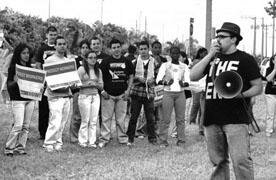Race-ing the gap between good health care coverage and great health
Featured, Health — By Andrew Grant-Thomas on April 7, 2010 at 1:37 pmThe recently passed health care reform bill, formally known as the Patient Protection and Affordable Care Act, will do much to support the health of people of color, not least through its expansion of Medicaid coverage to the near-poor and to childless adults mostly excluded from coverage previously.
Businesses with more than 50 employees will have to provide insurance to them all and private insurers will no longer be able to deny coverage to people with preexisting conditions. As psychiatrist Flavio Casoy notes in his excellent overview of the law, such measures “will be a lifeline for millions of people of color who are now blocked from getting health care services they desperately need.”
Bravo! But let’s not mistake the milestone for our destination.
The new health-reform law is but one cornerstone in the edifice we must build to support long, healthy lives for all our people. For one thing, according to the Congressional Budget Office, by 2019, years after all the law’s provisions will have gone into effect, an estimated 23 million people will remain uninsured. Undocumented immigrants, nine in ten of them people of color, will comprise roughly one-third of that number. Nonwhites will also be prominent among those who earn too much to qualify for Medicaid but too little to afford even a subsidized insurance plan. The Patient Protection and Affordable Care Act is a major step in the right direction, but it is not universal health care.
We also know that insurance coverage guarantees neither access to quality health care nor good health, and here, too, minorities suffer in comparison to whites. Broader coverage will not in itself increase the number, capacity, or cultural competence of health professionals in the underserved communities that are home to so many racial and ethnic minority group members. Indeed, extending coverage without increasing the number of primary care providers may well deepen racial inequities in health by further straining health care capacity in under-resourced areas.
Since the passage of near-universal healthcare in Massachusetts in 2006, emergency room visits in the state have spiked, fed largely by demand from newly insured patients with conditions best treated by primary care doctors. As Dr. Sandra Schneider of the American College of Emergency Physicians observes, “Just because you have insurance doesn’t mean there’s a physician who can see you.” Increasing the supply of primary care providers qualified to meet the needs of residents in all our nation’s communities is a critical arena in which much remains to be done.
Beyond the matter of access to care, people of color often receive lower quality of care than whites do. In Unequal Treatment, the landmark report issued by the Institutes of Medicine in 2003, the study committee concluded that the poorer health outcomes suffered by racial minorities relative to whites was due in part to their “unequal treatment” at the hands of health care providers and within health care systems.
Nonwhites are less likely to get lifesaving heart medications, bypass surgery, dialysis, or kidney transplants. They are more likely to have feet and legs amputated for late-stage diabetes treatment. Three in ten Latinos say they have had a problem communicating with health providers; two in ten say they have had difficulty getting care because of their race or ethnic background. In a 2005 survey conducted by the American Medical Association, 55 percent of physicians responding agreed that “minority patients generally receive lower quality care than white patients.” Two in three acknowledged having seen a patient receive poor care because or his or her race or ethnicity. The new healthcare law calls for enhanced data collection and reporting on race and ethnicity, as well as on sex, primary language, disability and for underserved rural and frontier populations. That call is to be applauded. Unfortunately, the law includes few measures aimed at the issues of racial inequities of health care raised in Unequal Treatment.
Looking ahead, we must insist that questions of coverage, provider numbers and capacity, and quality of care be asked and answered thoughtfully and forcefully. However, the most critical oversight in the national debate over health reform concerns the social determinants of health.
These are the social conditions, shaped by distributions of power, interests and resources, and given form by policy decisions, that most account for racial group disparities in health – food quality, poverty, working conditions, social exclusion, neighborhood environment, housing, social networks, exposure to chronic stress, discrimination, the diffusion of medical technology, and more. The Centers for Disease Control and Prevention has long suggested that suboptimal health care quality and access accounts for about 10 percent of premature deaths in the United States. Simply put, there is far more to health than health care.
Consider, for example, the racial geography of health. In 2000, black and Latino children were 32 percent of all children in the United States but were 84 percent of children living in severely distressed neighborhoods – defined as areas with high rates of poverty and high percentages of single-mother families, high school dropouts, and jobless adult males. One in 100 white children lived in such neighborhoods, as did one in four black children and one in eight Latino children. In 82 metropolitan areas, the typical poor black child lived in a neighborhood with a poverty rate of at least 20 percent. The same was true for poor white children in only five metropolitan areas.
Why dwell on these comparisons? Because we know that the physical and social conditions of neighborhoods shape their residents’ access to differing bundles of social, psychological, and economic resources and opportunities: access to healthy or unhealthy foods, more or less crime and safety, parks and jogging trails, playgrounds, pollution and toxins, social disorder, trust and cohesion, and the like.
In the words, of the Robert Wood Johnson Foundation’s Commission to Build a Healthier America, variations along these dimensions of neighborhood life have been linked repeatedly to a range of health outcomes, including “mortality, general health status, disability, birth outcomes, chronic conditions, health behaviors and other risk factors for chronic disease, as well as with mental health injuries, violence and other important health indicators.” Even when the causal pathways are unclear, this much we know: poor, racially isolated neighborhoods exact a terrible toll on the people who live there.
Creating “neighborhoods of opportunity” for all – and otherwise forging policy responses that account for what we know about the social determinants of health – is a formidable challenge, but one we can meet.
We could consistently site new affordable housing developments in low-poverty, high-opportunity neighborhoods that improve rather than depress residents’ life chances.
We could subsidize the movement of supermarkets, farmers markets, and other sources of fresh fruits and vegetables into communities that desperately need them.
We could fashion school assignment plans that don’t condemn low-income children of color to substandard schools.
We could implement zoning changes that reduce the concentration of pollution and hazardous wastes in already-disadvantaged neighborhoods.
We could convert vacant land into community gardens and urban parks. We could provide more classes for parents on the critical importance of diet, exercise and immunizations for their children’s well-being.
We could greatly reduce the spatial and social isolation of so many African Americans and Latinos through stricter monitoring of housing market practices, stronger enforcement of fair housing laws, expanded use of housing mobility programs, and more targeted homeownership assistance.
We could do these things and more. And we must.
None of this is to suggest that the struggle for better health care is over. As Atul Gawande notes in The New Yorker (“Now What?”, April 5), even with passage of the Patient Protection and Affordable Care Act a number of hurdles must be overcome before its limited-but-important promise is realized.
These challenges include the anti-reform lawsuits planned by at least a dozen state Attorneys General, public ambivalence, and an energized opposition. Moreover, the slow phase-in of key provisions of the law will make it vulnerable to attack well beyond the immediate legal and political battles. And even then, Gawande observes, will the communities charged with making the provisions of the law work actually muster the creativity and thoughtfulness to do so? There are no chickens to be counted here.
The point is that even if all these challenges are met, we have much more – and even more critical – work to do.
Tags: Barack Obama, equity, Health, health care, Patient Protection and Affordable Care Act, Politics, Racial EquityAuthor: Andrew Grant-Thomas (15 Articles)

Andrew Grant-Thomas is Deputy Director of the Kirwan Institute. He directs the Institute’s internal operations and oversees much of its US-based programming. His substantive interests include structural racism and implicit bias, alliance-building between immigrants and African Americans, African American males and gender dynamics within the African American community, and the promotion of systems thinking through videogames. Andrew serves as Associate Editor of the Institute’s journal, Race/Ethnicity: Multidisciplinary Global Contexts. He also edited Twenty-first Century Color Lines: Multiracial Change in Contemporary America, published in 2008 by Temple University Press. He is a regular contributor to Racewire.org and WOSU radio and sits on the boards of several nonprofit organizations and various social justice initiatives. Andrew came to the Kirwan Institute in February of 2006 from the Civil Rights Project at Harvard University where he directed the Color Lines Conference and managed a range of policy-oriented racial justice projects. He received his B.A. in Literature from Yale University, his M.A. in International Relations from the University of Chicago, and his Ph.D. in Political Science from the University of Chicago.


 Share This
Share This Tweet This
Tweet This Digg This
Digg This Save to delicious
Save to delicious Stumble it
Stumble it





 A train ride with a token Indian
A train ride with a token Indian Help make US Gov. own up to its racial disparities and eliminate them
Help make US Gov. own up to its racial disparities and eliminate them The zero-sum argument that pits black Americans against undocumented workers is a false premise
The zero-sum argument that pits black Americans against undocumented workers is a false premise








1 Comment